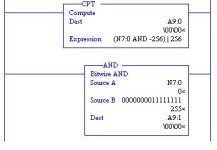Is there a way to convert these integers (17476,16688,13110,12598) to Ascii character (DDA03616)?
17476 = 4444hex = DD on ascii chart
16688 = 4130hex = A0 on ascii chart
13110 = 3336hex = 36 on ascii chart
12598 = 3136hex = 16 on ascii chart
We are using a Allen Bradley PLC5.
Thanks for any responses.
17476 = 4444hex = DD on ascii chart
16688 = 4130hex = A0 on ascii chart
13110 = 3336hex = 36 on ascii chart
12598 = 3136hex = 16 on ascii chart
We are using a Allen Bradley PLC5.
Thanks for any responses.




